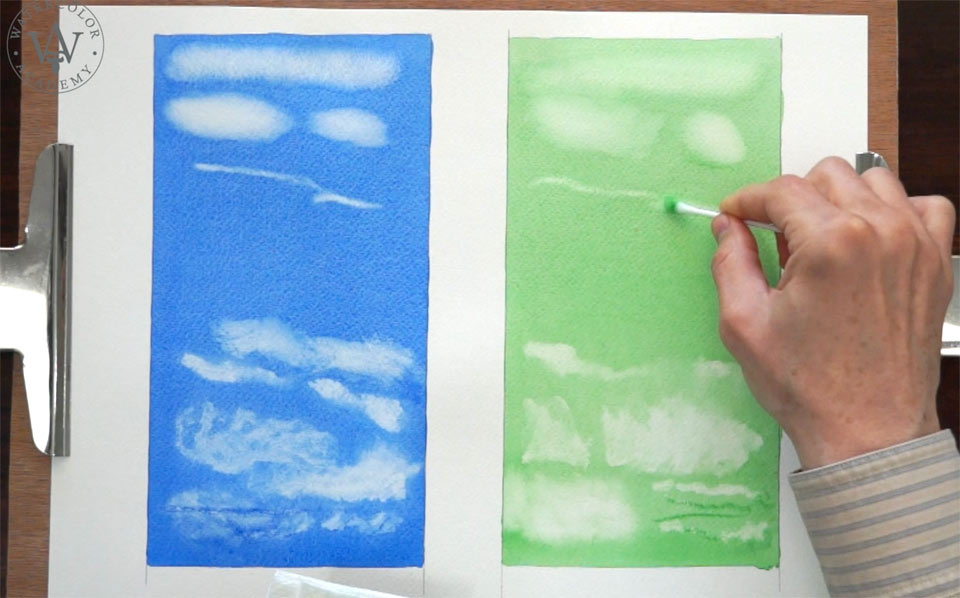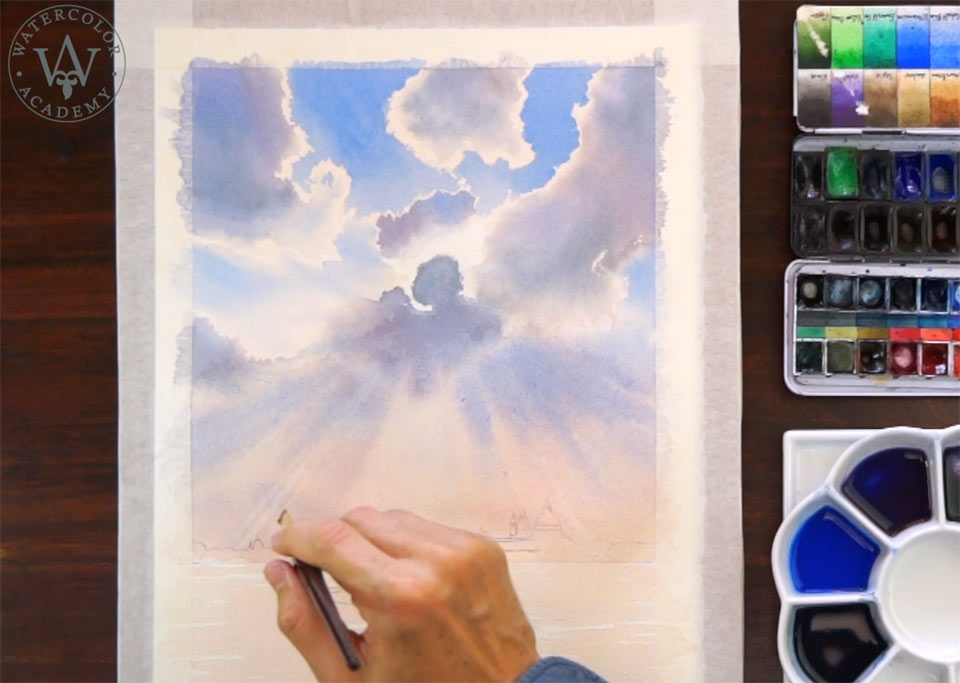A self-study, self-paced course where you can learn how to paint in watercolor by watching video lessons and doing assignments
$297 USD
ENROLL NOWA self-study, self-paced course where you can learn how to paint in watercolor by watching video lessons and doing assignments
$297 USD
ENROLL NOWOne-to-one, unlimited and custom-tailored to your skills and needs Personal Tutoring by the Watercolor Academy teachers
$997 USD
ENROLL NOWVideo lesson by Vladimir London
In this video lesson, you will discover the 'wiping off' and 'washing out' methods, and how to use them in watercolor painting.
To demonstrate to you the wiping out and washing out painting methods, I will first make a plain wash. For this purpose, I fixed the watercolor paper sheet to the board, placed this board with a tilt of about 15 degrees, and pre-mixed blue paint in the saucer. I will skip the explanation of how to do a plain saw wash, because I have already demonstrated and explained this method several times in previous video lessons.

This wash is complete, and while the paper surface is still wet, I wash the brush and dry it with a paper towel, so that I can use it for wiping out wet paint from the paper surface. I have to pint your attention that the brush is not fully dry, but damp, as a completely dry brush will not take the paint so readily.
You can wipe out wet paint not only with a brush, but also with a paper napkin or a towel. For the same purpose, you can also use cotton bud sticks, or a piece of organic or synthetic sponge. Once again, it is better to make it damp before wiping out wet paint from the paper surface. Now, I will make another plain wash and let it dry, in order to demonstrate the washing out painting method. I will fast forward to the finished wash, because we have already covered how to do this in previous video lessons of the Watercolor Academy course.
Before we perform the 'washing out' technique, I would like to repeat the 'wiping out' method once again, whilst the plain wash is still wet. The damp brush absorbs paint quite well. The same happens with bloating the painted surface with a paper napkin. Keeping the napkin moist improves the process.
The natural sponge also has to be prepared for wiping out. After dipping the sponge in clean water, I dry it out by squeezing it into the paper towel. A sponge absorbs wet paint better when it is damp.
If you use a dry cotton stick however, instead of wiping out the paint, it may actually damage the paper surface, leaving dark marks. To resolve this, the cotton stick has to be moistened first and then dried with a paper napkin, in order to absorb wet paint more efficiently. Using a cotton stick makes it easier to wipe out thin lines with higher precision. Now, the blue wash is totally dry. The damp brush will not take any paint from it. It is too late to use the 'wiping out' method. That is why, before removing any pigment, I have to wet the paper surface first, which is what I am doing right now. Depending on the pigment and paper, it may take some time and effort to dilute the paint layer. When it is wet, I can finally wash out some pigment with a damp brush.
I have to say that washing out doesn't work well for every single paint. Some dyes will go deep into paper fibres, and it will be very difficult, if not impossible, to remove the color without damaging the paper surface.

Washing out works better for coarser and larger particle pigments that sit on the paper surface and are easier to remove. I am now demonstrating the wiping out process with an organic sponge. Because I can apply a higher pressure on the sponge, and it has a better ability to release and absorb water, it produces better results of wiping out than a synthetic brush. Also, it is easier to achieve soft borders with a moist sponge. Now, I will wipe out paint with a cotton stick. This way, I can make thinner, more controlled lines, which may be useful in some cases.
You have to keep in mind that wiping out wet paint is easier and gives better results than washing out colored pigments after paint dries. Ideally, you should not use 'washing out' as your preferable watercolor painting method. This may be one of the ways of fixing errors, but your goal as an artist is not to make mistakes which have to be fixed after the paint dries.
The 'wiping out' method, however, can be a part of your watercolor painting routine. At the same time, it is better to learn more proficient ways of preserving white areas, such as by painting around these areas, either on a wet or dry paper surface. Should you master the professional watercolor painting techniques, you will find that 'wiping out' is not the best way to preserve white areas of an artwork, and washing out is not needed at all if everything goes as it should. Nevertheless, having the knowledge and experience of both 'wiping out' and 'washing out' will help you to become a more proficient watercolor artist.
A self-study, self-paced course where you can learn how to paint in watercolor by watching video lessons and doing assignments
One-time payment - Lifetime membership
$297 USD
One-to-one, unlimited and custom-tailored to your skills and needs Personal Tutoring by the Watercolor Academy teachers
One-time payment - Lifetime membership
$997 USD